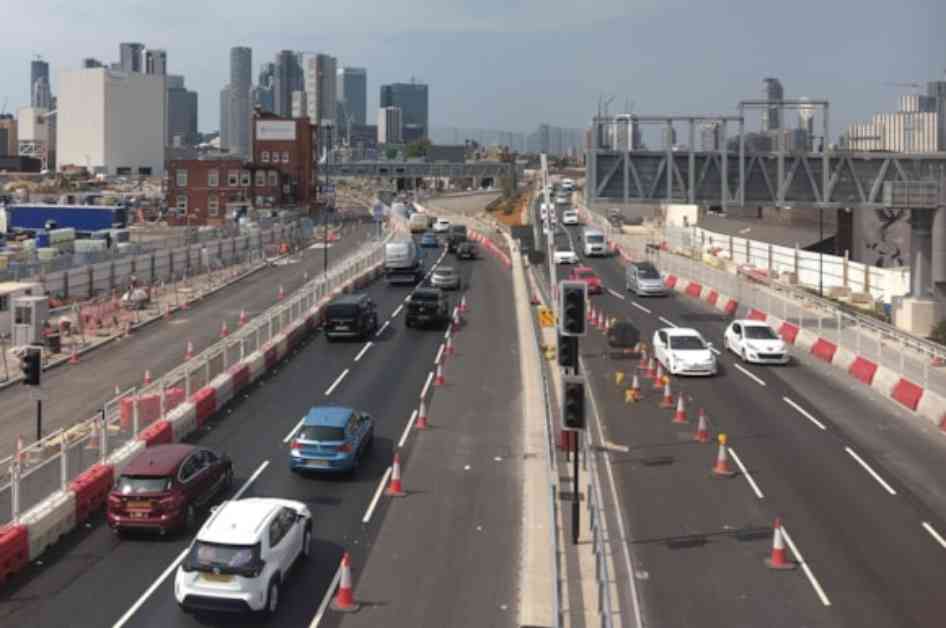The closure of the southbound Blackwall Tunnel this weekend marks a significant step in the preparations for the opening of the new Silvertown Tunnel. From 12.01am on Saturday, August 17, until 5am on the Monday morning, southbound traffic will be redirected to allow for essential road resurfacing, safety barrier works, and final road configuration adjustments. This closure is part of a series of planned disruptions to facilitate the completion of the Silvertown Tunnel project, with another closure scheduled from September 7 to September 9.
The Silvertown Tunnel project was initiated in 2012 to alleviate the chronic congestion that plagues residents and businesses in east London, particularly around the Blackwall Tunnel. The existing Victorian-era tunnel is prone to frequent closures, exceeding 700 times a year, leading to traffic congestion, poor air quality, and significant time wastage for drivers stuck in gridlocked conditions. The new Silvertown Tunnel aims to reduce journey times, manage air pollution, and increase the capacity for buses to cross the river in this area during peak hours.
Drivers are advised to plan their routes in advance and check for any potential traffic impacts or restrictions, such as height and weight limits at alternative river crossings like the Rotherhithe Tunnel and Tower Bridge. With the closure of the Blackwall Tunnel for southbound traffic, roads and alternative river crossings in east and central London are expected to experience heavier traffic flows, particularly around the Rotherhithe Tunnel and along the A13 Commercial Road between Canning Town and Whitechapel.
To assist drivers in navigating the closures, additional variable messaging signs will be placed on main roads leading to the Blackwall Tunnel, and collaboration with third-party navigation app providers like Waze will ensure that drivers are informed of the closures and offered alternative routes. The Woolwich Ferry, operating every fifteen minutes, seven days a week, will provide an additional river crossing option for drivers affected by the Blackwall Tunnel closure.
For HGVs and vans exceeding two meters in height or two tonnes in weight, it is advisable to consider alternative routes away from central London during the closure weekends. The route 108 bus service, the sole bus route passing through the Blackwall Tunnel, will be divided into two segments, operating between Lewisham and North Greenwich and between Canning Town and Stratford. Passengers are encouraged to transfer onto the Jubilee line to cross the river and complete their journeys seamlessly.
TfL has taken steps to ensure that customers of the route 108 who use the Jubilee line as part of their journey during the closure weekends will receive automatic refunds for the Tube section of their travel. Additionally, the Mayor’s Hopper fare allows customers to make additional bus journeys on the opposite side of the river within an hour of boarding the initial bus without incurring extra charges. Northbound buses will resume their normal route at 12.01am on Monday mornings following the closure weekends, while southbound buses will be diverted via Tower Bridge until the Blackwall Tunnel reopens to southbound traffic.
Nick Fairholme, Director of Capital Delivery – Systems at TfL, emphasized the importance of these planned closures in preparing for the opening of the Silvertown Tunnel. He acknowledged the potential impact on drivers and reassured that efforts were being made to minimize disruptions, including maintaining a northbound route through the Blackwall Tunnel throughout the closure periods.
Impact on Traffic and Commuters
The closure of the southbound Blackwall Tunnel and the subsequent rerouting of traffic will undoubtedly have a significant impact on commuters and road users in the affected areas. With the closure spanning an entire weekend, drivers will need to plan their journeys carefully to avoid potential delays and congestion. The diversion of southbound traffic to alternative routes may result in increased traffic volumes on surrounding roads, particularly around the Rotherhithe Tunnel and along the A13 Commercial Road.
Commuters relying on the route 108 bus service will experience changes to their usual travel patterns, as the service will be split into two segments during the closure weekends. Passengers are advised to transfer onto the Jubilee line to cross the river and complete their journeys, with automatic refunds available for the Tube section of their travel. The Mayor’s Hopper fare offers additional convenience for bus passengers, allowing them to make extra journeys on the opposite side of the river within an hour of boarding their initial bus.
Benefits of the Silvertown Tunnel
The construction of the Silvertown Tunnel represents a crucial infrastructure development aimed at addressing the longstanding issues of congestion and air pollution in east London. The new tunnel is designed to reduce journey times, alleviate traffic congestion, and improve air quality in the surrounding areas. By providing an additional river crossing option, the Silvertown Tunnel will enhance connectivity and accessibility for residents and businesses in east London.
Furthermore, the Silvertown Tunnel project will enable TfL to increase the capacity for buses to cross the river, from five to 21 buses per hour in each direction during peak times. This improvement in public transportation services will offer commuters more reliable and efficient travel options, reducing reliance on private vehicles and contributing to a more sustainable urban transport system. The Silvertown Tunnel is expected to play a vital role in enhancing the overall transportation network in east London and promoting economic growth in the region.
Future Implications and Considerations
As the completion of the Silvertown Tunnel project nears, it is essential to consider the broader implications and long-term benefits of this infrastructure development. The new tunnel will not only improve connectivity and accessibility in east London but also contribute to the overall sustainability and efficiency of the transportation network in the region. By reducing congestion, managing air pollution, and enhancing public transportation services, the Silvertown Tunnel will create a more livable and environmentally friendly urban environment for residents and businesses.
As the project progresses, it is crucial for TfL to continue engaging with stakeholders, monitoring traffic patterns, and assessing the impact of the new tunnel on the surrounding areas. By addressing potential challenges and implementing effective mitigation measures, TfL can ensure a smooth transition to the operation of the Silvertown Tunnel and maximize its benefits for the community. The successful completion of the Silvertown Tunnel project will mark a significant milestone in the ongoing efforts to enhance transportation infrastructure and promote sustainable urban development in east London.





















